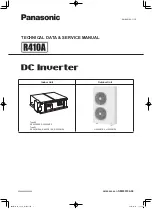
Model 100199
SPECIFICATIONS
19
© 2015 Champion Power Equipment
Part No. 101049 Rev. B
ALTERNATOR OVERVIEW
The alternator is made up with the following major components;
1. Brush holder assembly
2. Rear bearing carrier
3. 2 pole rotor (all copper wire)
4. Stator assembly (all copper wire)
5. Engine adaptor
ROTOR ASSEMBLY
The alternator has a 2-pole rotor, which means the rotor has
a single south magnetic pole and a single north magnetic
pole. As the rotor spins, its magnetic
fi
eld passes through the
stator assembly windings and voltage is induced into the stator
windings. This is known as induction. The rotor shaft has a
negative (-) slip ring and a positive (+) slip ring, with the negative
(-) nearest the bearing carrier. The rotor shaft is held in place
with single through bolt.
STATOR ASSEMBLY
The stator houses, AC power windings and excitation windings.
It is held in place with 4 bolts that pass through the bearing
carrier and engine adaptor, then attached to the engine mounting
fl
ange. In combination with the rotor assembly, they generate the
electrical out-put of the HSB.
BRUSH HOLDER AND BRUSHES
The brush holder is a component that holds the brushes in a
stationary position enabling them to maintain contact with the
rotating surface commutator rings on the rotor. The brush holder
is attached to the rear bearing carrier by means of a M5 x 20
bolt and a location tab. A negative (-) brush and a positive (+)
brush are retained in the brush holder. The negative (-) brush
rides on the slip ring nearest the bearing carrier. The brushes are
spring loaded to maintain contact.
A RED wire connects to the positive (+) brush and a BLACK
wire to the negative (-) brush. Recti
fi
ed and regulated excitation
current, as well as current from the
fi
eld boost circuit, are
delivered to the rotor windings via the RED wire, and the positive
(+) brush and slip ring. The excitation and
fi
eld boost current
passes through the windings and to the frame ground via the
negative (-) slip ring and brush, and the BLACK wire.
The current
fl
ow creates a magnetic
fi
eld around the rotor having
a
fl
ux concentration that is proportional to the amount of current
fl
ow.
















































